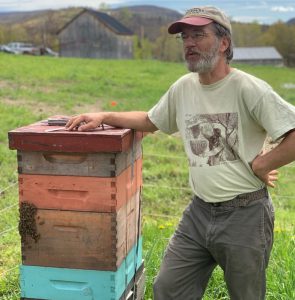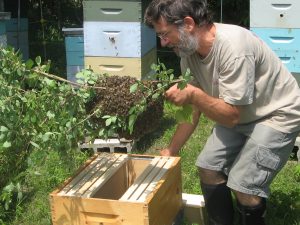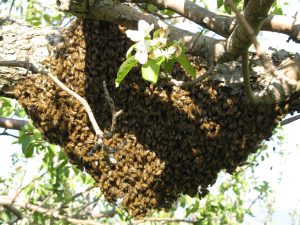Click Here if you listened. We’d love to know what you think. There is even a spot for feedback!
Read along below!

Swarm Catching
Thoughts and Tips for Success
By: Ross Conrad
It’s that time of year again. The days are getting longer and temperatures are getting warmer. Flowers are popping up all over and the bees are thinking about reproductive swarming. For beekeepers, this is an opportunity to add new colonies to our apiaries with minimal financial expense. There are lots of ways to go about catching swarms so rather than attempt to cover them all in an article, we’ll just look at some universal ideas that apply to most swarm catching situations.
Passive Approach
The easiest way is to set up a bait hive, or swarm trap, and wait for a swarm to come to you. According to research, the ideal cavity sought out by a swarm is considered to be about 45 liters in size (about the size of a deep hive body), located in the shade, with a small entrance (two to five square inches) that faces south, and elevated roughly 15-20 feet off the ground. However, it is not uncommon for swarming bees to move into stacks of empty hive bodies and supers that form a cavity much larger than 45 liters, with no entrance reducer and numerous entrances facing various directions, while sitting in full sun, and elevated just inches from the ground; so I don’t get too hung up on the ideal swarm cavity as suggested by scientific research.
The attractiveness of any swarm trap and bait hive is improved with the use of a lure. Swarm lures, typically composed of bee pheromones, are available from many supply companies. Alternatively, bait hives stocked with frames of foundation or drawn comb emit the scent of beeswax that may attract scout bees looking for a suitable cavity for their swarming colony. Just be sure to pre-treat any frames of drawn comb with the non-toxic wax moth control Certan (B-402), or if no swarm has moved in, remove the comb and protect it before it gets too late in the season to prevent wax moth larvae damage.

The greatest chance of success in swarm capture happens when minimal disturbance of the cluster occurs and the entire swarm can be gently placed directly into a hive.
Location, Location, Location
One of the best places to locate swarm traps and bait hives is within a few hundred yards of an existing beeyard to take advantage of any swarms emanating from that apiary. It doesn’t matter if it is your apiary or not. One of the defining characteristics of beekeeping is that we are dealing with semi-wild creatures. Once a swarm emerges from a hive it becomes fair game to the first person who spots it and can capture it.
The most convenient place to locate a swarm trap is in a place that you frequent regularly, especially if the trap is not located in the final resting place you have in mind for your hive. This way you will notice the swarm early in the process after the bees have moved in, and relocating the developing colony to its permanent home before it grows too large and weighs too much is more easily accomplished. This is particularly important if a bait hive is located at a significant height off the ground.
Swarm Catching Equipment
A more active approach is to attempt to capture swarms manually. Almost any container can be used to catch a swarm. However, when possible I find it preferable to use a hive body filled with frames of comb or foundation. This eliminates the need to transfer the swarm from a swarm capturing container such as a cardboard box, plastic bucket or paper bag and into a permanent hive. Stapling the hive components together helps keep the hive from coming apart when moving a captured swarm. I prefer however, to strap my hives together rather than use staples to avoid the damage that staples cause to the woodenware.
As exciting as it is to try to catch a swarm of bees, it is even more exciting when the swarm stays in the hive they have been introduced to. To increase the chances of the swarm staying put, it helps to move and interfere with the new colony as little as possible during the capturing process and minimize disturbing the colony for the first week or so after capture. If the location where the swarm is initially captured is outside of an electric fence, I will carry it back to the apiary where the fence will protect the bees from bears. I only seal up the entrance with a screen and load a captured swarm into a vehicle to transport it to its permanent home when it is not within walking distance of one of my existing beeyards. Then, I prefer to wait about a week to give the bees plenty of time to settle in and allow the queen to start laying eggs before inspecting the new colony. Too much movement or hive manipulation early in the process can cause the bees to abandon the cavity you are providing rather than use it to create their new home. Instead of opening up the hive if you are impatient and curious, simply observe the colony’s entrance during warm and dry weather to see if foragers are coming and going and that will tell you if the swarm has settled in or has abandoned the hive.
To Maximize Chances of Success, Time is of the Essence
A critical aspect of successful swarm capture is your timing. Swarming bees almost always bivouac somewhere nearby, shortly after they emerge from the parent hive. Once they land nearby, a swarm should be allowed at least 15-20 minutes to settle down and organize their cluster. To conserve food resources, the bees forming the exterior of the cluster will allow their body temperature to drop below that required for flight. Attempt to capture the swarm too early before they have settled into a cluster and cooled off, and all the bees will simply take to the air and either return to their old hive or to the place the swarm originally settled.
After the swarm has formed a cluster around the queen, the scouts fly out in search of a new cavity for the colony to call home. Once a suitable nest site is located and the majority of the scouts agree on its suitability, the scouts emit piping sounds that signal the rest of the bees in the cluster to raise their body temperature and prepare to take flight. If you hear piping sounds emanating from a cluster of swarming bees, it is too late to try to capture them easily. They have already found a new home and the swarm can be expected to leave shortly for the new nesting site. The only way to potentially prevent a piping swarm from leaving is to place the swarm in a hive equipped with a queen excluder that prevents the queen from departing with the swarm.

April showers bring May flowers and swarms! Don’t pass up this opportunity to increase your hive numbers with minimal expense.
Follow the Queen
Another critical aspect of swarm capture is being sure to catch the queen. This is another reason to allow the majority of swarming bees to get settled and cool down prior to attempting to hive them. If a swarm is hanging from an accessible branch, simply bumping or shaking the branch in the direction of the container you want to capture them in, will cause the bees at the base of the swarm clinging to the branch to lose their grip resulting in the entire cluster dropping into any container placed directly below them. This is because the cool bees that make up the exterior of the cluster, and are not at flight temperature, will prevent the warmer bees surrounding the queen on the inside of the cluster from being able to easily take to the air as the cluster falls. This increases the chances that the queen, along with the vast majority of the bees, will drop into your swarm capturing container. Quickly, but gently, sealing up the container after the swarm drops into it will help keep many of the bees from leaving and they will instead start investigating the inside of the cavity and hopefully get comfortable enough to want to stay.
Gathering Stragglers
When attempting to capture a swarm, there will inevitably be stragglers. Some will take to the air during the initial capturing process, some will leave the container after the swarm has been placed into, or never make it into the container to begin with and fall onto the ground nearby. By leaving a small entrance opening on the swarm capturing container and patiently waiting for the stray bees to follow the scent of the queen, or the Nasonov gland pheromone of the workers, eventually most of the stragglers will make their way into the container being use to capture the swarm.
After shaking the swarm cluster off a branch, or scooping the majority of the bees off the wall of a building, etc., the process of gathering the stray bees can be sped up by blowing smoke onto the place where the swarm originally settled. The smoke will cover the smell of the pheromones left behind at that location and increase the speed that the bees will rediscover the scent of their queen and follow the rest of the colony into the swarm capturing container, provided of course that you managed to gather the queen up with the bulk of the swarm in the first place.
Taking Full Advantage of the Bees Natural Tendencies
Don’t forget that unless the swarm is extremely small, or has been clustered outside their hive for several days and has used up much of the honey they took with them, it is primed to start producing substantial amounts of comb quickly. Take advantage of this fact by being sure that their new home is stocked primarily, if not completely, with frames of foundation in order to get fresh new comb built.
Some people hypothesize that regularly capturing swarms leads to apiaries filled with bees that are genetically predisposed to swarming. In reality, honey bees are already predisposed to swarm although some are genetically predisposed more than others. Additionally, when the colony is healthy and populous, the hive can get so full it becomes congested causing the bees to want to swarm. If capturing swarming bees genetically predisposes them to swarm in the future, then perhaps it also selects for colonies healthy enough to swarm in the first place. I am not one to overly worry about swarming bees since the natural brood break created through swarming is one of the ways colonies naturally manage varroa mite loads and stay healthy, and healthy bees are much more important to me than whether they swarm or not.
Ross Conrad is author of Natural Beekeeping and the Land of Milk and Honey: A history of beekeeping in Vermont. Ross will be teaching a two-day intensive Beekeeping for Beginners class May 18-19, 2024 in Lincoln, Vermont. For more information visit dancingbeegardens.com






